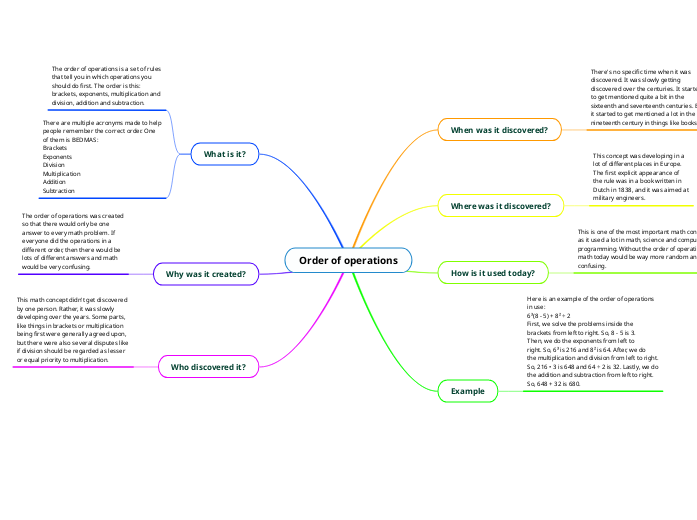Order of operations
When was it discovered?
There's no specific time when it was
discovered. It was slowly getting
discovered over the centuries. It started
to get mentioned quite a bit in the
sixteenth and seventeenth centuries. But
it started to get mentioned a lot in the
nineteenth century in things like books.
Where was it discovered?
This concept was developing in a
lot of different places in Europe.
The first explicit appearance of
the rule was in a book written in
Dutch in 1838, and it was aimed at
military engineers.
How is it used today?
This is one of the most important math concepts
as it used a lot in math, science and computer
programming. Without the order of operations,
math today would be way more random and
confusing.
Example
Here is an example of the order of operations
in use:
6³(8 - 5) + 8² ÷ 2
First, we solve the problems inside the
brackets from left to right. So, 8 - 5 is 3.
Then, we do the exponents from left to
right. So, 6³ is 216 and 8² is 64. After, we do
the multiplication and division from left to right.
So, 216 • 3 is 648 and 64 ÷ 2 is 32. Lastly, we do
the addition and subtraction from left to right.
So, 648 + 32 is 680.
What is it?
The order of operations is a set of rules
that tell you in which operations you
should do first. The order is this:
brackets, exponents, multiplication and
division, addition and subtraction.
There are multiple acronyms made to help
people remember the correct order. One
of them is BEDMAS:
Brackets
Exponents
Division
Multiplication
Addition
Subtraction
Why was it created?
The order of operations was created
so that there would only be one
answer to every math problem. If
everyone did the operations in a
different order, then there would be
lots of different answers and math
would be very confusing.
Who discovered it?
This math concept didn't get discovered
by one person. Rather, it was slowly
developing over the years. Some parts,
like things in brackets or multiplication
being first were generally agreed upon,
but there were also several disputes like
if division should be regarded as lesser
or equal priority to multiplication.
